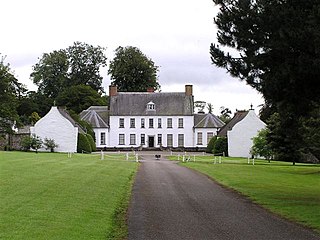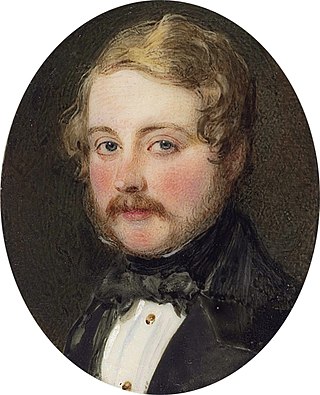
Marquess of Bristol is a title in the Peerage of the United Kingdom held by the Hervey family since 1826. The Marquess's subsidiary titles are Earl of Bristol, Earl Jermyn, of Horningsheath in the County of Suffolk (1826), and Baron Hervey, of Ickworth in the County of Suffolk (1703). The Hervey barony is in the Peerage of England, the earldom of Bristol in the Peerage of Great Britain and the Jermyn earldom in the Peerage of the United Kingdom. Earl Jermyn is used as courtesy title by the Marquess's eldest son and heir. The Marquess of Bristol also holds the office of Hereditary High Steward of the Liberty of St Edmund. The present holder of these titles is Frederick Hervey, the 8th Marquess and 12th Earl of Bristol.

John Hervey, 1st Earl of Bristol was an English Whig politician.

Frederick Augustus Hervey, 4th Earl of Bristol,, was an 18th-century Anglican prelate.

Frederick William Hervey, 1st Marquess of Bristol, styled Lord Hervey between 1796 and 1803 and known as The Earl of Bristol between 1803 and 1826, was a British peer.

Springhill is a 17th-century plantation house in the townland of Ballindrum near Moneymore, County Londonderry in Northern Ireland. It has been the property of the National Trust since 1957 and, in addition to the house, gardens and park, there is a costume collection. It is open from March to June, and September on weekends, and is open to the public seven days a week during July and August.

Ickworth House is a country house at Ickworth, near Bury St Edmunds in Suffolk, England. It is a neoclassical building set in parkland. The house was the residence of the Marquesses of Bristol until 1998; the house was given to the National Trust in 1956, but between then and 1998 the marquesses leased the east wing.

Mussenden Temple is a small circular building located on cliffs near Castlerock in County Londonderry, high above the Atlantic Ocean on the north-western coast of Northern Ireland.

Castlerock is a seaside village in County Londonderry, Northern Ireland. It is five miles west of Coleraine, and part of Causeway Coast and Glens district. It is very popular with summer tourists, with numerous apartment blocks and two caravan sites. Castlerock Golf Club has both 9-hole and 18-hole links courses bounded by the beach, the River Bann and the Belfast to Derry railway line. The village had a population of 1,155 people at the 2021 census, and is where near by village Articlave F.C play their home games.

St Columb's Cathedral in the walled city of Derry, Northern Ireland, is the cathedral church and episcopal see of the Church of Ireland's Diocese of Derry and Raphoe. It is also the parish church of Templemore. It is dedicated to Saint Columba, the Irish monk who established a Christian settlement in the area before being exiled from Ireland and introducing Christianity to Scotland and northern England. Built after the Reformation in Ireland, St Columb's is the first Anglican cathedral to have been built in Britain and Ireland after the Reformation and was the first non-Roman Catholic cathedral to be built in Western Europe.
Downhill is a small village and townland near Castlerock in County Londonderry, Northern Ireland. It is situated within Causeway Coast and Glens district. It was visited by the Lewis brothers in their childhood, when, in July 1901, their nurse took them for a visit while on a holiday in Castlerock.

Ballyscullion is a small village and civil parish in County Londonderry, Northern Ireland. In the 2001 census it had a population of 291 people. The civil parish of Ballyscullion covers areas of County Antrim as well as County Londonderry. The village is situated within Mid-Ulster District.

Elizabeth Christiana Cavendish, Duchess of Devonshire was an English aristocrat and letter writer. She is best known as Lady Elizabeth Foster, the close friend of Georgiana Cavendish, Duchess of Devonshire. Elizabeth supplanted the Duchess, gaining the affections of William Cavendish, 5th Duke of Devonshire and later marrying him. Several of her letters are preserved.

The so-called Temple of Vesta is a small circular Roman temple in Tivoli, Italy, dating to the early 1st century BC. Its ruins are dramatically sited on the acropolis of the Etruscan and Roman city, overlooking the falls of the Aniene and a picturesque narrow gully.

Banagher is a parish in County Londonderry, Northern Ireland. The parish is made up of the medieval parish of Banagher and parts of the ancient parish of Boveva and the townland of Tireighter and Park, once in the parish of Cumber. Banagher has many ancient monuments, including churches, holy wells, standing stones and chambered graves.

Horringer, formerly also called Horningsheath, is a village and civil parish in the West Suffolk district of Suffolk in eastern England. It lies on the A143 about two miles south-west of Bury St Edmunds. The population in 2011 was 1055.

Downhill House was a mansion built in the late 18th century for Frederick, 4th Earl of Bristol and Lord Bishop of Derry, at Downhill, County Londonderry. Much of the building was destroyed by fire in 1851 before being rebuilt in the 1870s. It fell into disrepair after the Second World War.

Sir Henry Hervey Bruce, 3rd Baronet PC (Ire) was an Irish Conservative politician. He was Member of Parliament for Coleraine from 1862 to 1874, and from 1880 to 1885.

Admiral Sir Henry William Bruce, was a Royal Navy officer who went on to be Commander-in-Chief, Portsmouth.
Baron Dunleath, of Ballywalter in the County of Down, is a title in the Peerage of the United Kingdom. It was created on 29 August 1892 for the businessman and former Conservative Member of Parliament for Downpatrick, John Mulholland. The Mulholland family were involved in the cotton and linen industry in Ulster in the north of Ireland. The first Baron's son, the second Baron, represented Londonderry North in the House of Commons as a Conservative. His grandson, the fourth Baron, was a member of the Northern Ireland Assembly for the Alliance Party. He was succeeded by his first cousin, the fifth Baron, who had already succeeded his father as second Baronet of Ballyscullion. As of 2017 the titles are held by the fifth Baron's son, the sixth Baron, who succeeded in 1997.
Sir Henry Hervey Aston Bruce, 1st Baronet was an Irish priest.
















